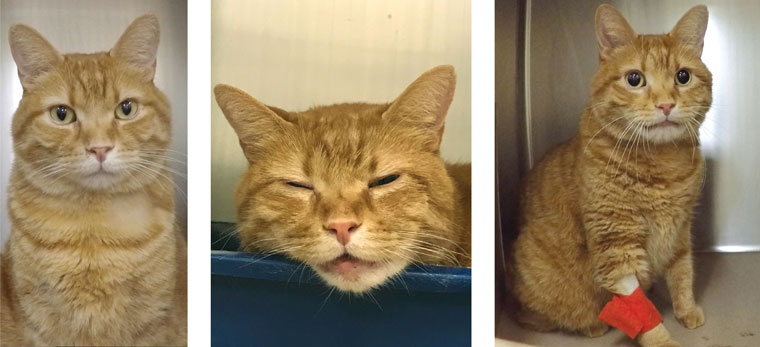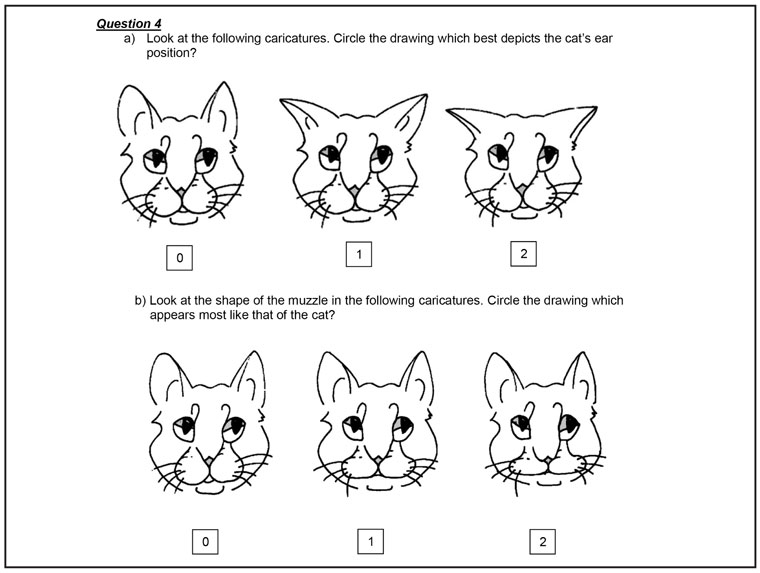
April 01, 2020
Pain points
The Feline Grimace Scale, a new tool to measure pain in cats, has met with a tremendous response in the veterinary community.
“There has been an increasing interest because the tool provides a simple and practical means of acute pain assessment using facial expressions in cats, a species that can notoriously hide signs of pain in the clinical setting,” said Dr. Paulo Steagall, an associate professor of veterinary anesthesia and analgesia at the University of Montreal.

Various tools have been developed in recent years for pain assessment in cats and dogs, as well as other animals. Some tools have not been validated for accuracy and sensitivity, and some are more thorough but therefore take more time to complete, but at least a few of these tools are finding a place in clinical practice.
Veterinarians and veterinary technicians can turn to pain scales to help measure acute pain in cats and dogs, as distinct from stress or fear. Other tools help veterinary professionals and pet owners together measure chronic pain associated with specific conditions in cats and dogs. Still other instruments help assess quality of life in pets.

Manage what you measure
Dr. Jennifer F. Johnson is president of the International Veterinary Academy of Pain Management and a certified veterinary pain practitioner with the IVAPM. She earned her veterinary degree in 1993, and after practicing for about 10 years, she felt like a pretty good clinician but found that she was spending extensive time figuring out diagnoses for certain pets.
“There were a couple of difficult cases where I realized that if I could concentrate on making them feel better, then I was markedly more successful,” she said. That piqued her interest in pain management.
Dr. Johnson later realized that while veterinary professionals can provide pain management, they can’t know whether it is working if they don’t measure outcomes. By then a practice owner in the Philadelphia suburbs, she held a staff meeting to develop an in-hospital pain scale with agreed-upon criteria to grade pain on a scale from 0 to 10.
The first popular tool for assessment of acute pain in cats and dogs came out of Colorado State University, Dr. Johnson said. The Colorado State score sheets include images depicting various postures alongside descriptions of psychological and behavioral signs, responses to palpation, and amount of body tension. The scales are helpful for general practitioners, but they haven’t been validated.
The Glasgow Composite Measure Pain Scales for cats and for dogs come from the University of Glasgow in Scotland and have been validated for assessment of acute pain. The Glasgow pain scale for cats includes an evaluation of facial expression, similar to the Feline Grimace Scale.

Dr. Dorothy Cimino Brown while at the University of Pennsylvania developed the Canine Brief Pain Inventory, which has been validated for assessment of chronic pain associated with osteoarthritis and bone cancer. Additionally, researchers at North Carolina State University developed the Feline Musculoskeletal Pain Index, which has been validated for assessment of chronic pain associated with degenerative joint disease.
Dr. Johnson, now a veterinary educator based in Arizona, has been teaching pain management since 2007. She said, “Animal pain—and especially the complexities of the development of chronic pain—in and of itself is still a mystery.”
Building on the work at Glasgow, NewMetrica was established in 2013 to offer the Glasgow Composite Measure Pain Scales and now the web-based VetMetrica Health Related Quality of Life Tool for cats and dogs, the latter for a user fee.
Dr. Johnson said, “The HRQL is a tool built for owners to assess a pet’s physical well-being as well as emotional well-being, with results being reported to the veterinarian as a tool for establishing early detection of health status in normal patients, a monitoring tool for animals under treatment, and a more objective guideline for end-of-life decision-making in chronic pain patients.”
She said the evaluation of a pet’s overall well-being can be a much more valid measure than just looking at pain per se.
A better window
Tasha McNerney is a member of the Academy of Veterinary Technicians in Anesthesia and Analgesia and a certified veterinary pain practitioner and board member with the IVAPM. She works at Mount Laurel Animal Hospital, a specialty practice in New Jersey.
For veterinary professionals who are brand new to pain scoring and intimidated by the longer forms, McNerney recommends learning more about the various pain scoring systems that are available to see which would be most practical for their clinic. She said the Colorado State pain scales are a good starting point, but she advocates using the Glasgow pain scales because they have been validated.
The nice thing about the Feline Grimace Scale is that it can be done quickly in an intensive care unit or with a lot of post-surgical patients, McNerney said. With the Glasgow scale, someone has to sit down, open the cage, and attempt to touch the animal.
McNerney said having nuanced pain scoring systems gives veterinary professionals a better window into whether patients need opioids, nonsteroidal anti-inflammatory drugs, ketamine, or multimodal pain management. Not every cat that undergoes a spay procedure or dog that undergoes a tibial-plateau-leveling osteotomy reacts the same way. She said, “We can take a little bit more care to make sure that the experience is curated especially for that patient and what kind of pain that patient is experiencing.”
At Mount Laurel Animal Hospital, veterinary technicians do comfort checks on patients every two to four hours after surgery. When the patient goes home, the practice provides the pet owner with a sheet of things to look for and keeps open lines of communication with the owner between rechecks. The rechecks involve a pain conversation and pain scoring.
Pain scoring has changed over the 15 years that McNerney has been doing it. When she started, the Colorado State scales were just getting off the ground. She said, “Now we are getting a little bit better at honing in on actual painful things, but also we are getting better as an industry at recognizing signs of stress in our patients.”
Throwing opioids at a patient is not going to solve stress, McNerney said. A practice instead needs to use low-stress handling techniques and possibly tranquilizers or anti-anxiety drugs.
Paying attention to cats
“The lack of pain assessment is one of the main reasons why analgesic administration has often been neglected in cats,” wrote Drs. Steagall and Beatriz P. Monteiro of the University of Montreal in “Acute pain in cats: Recent advances in clinical assessment,” a January 2019 article in the Journal of Feline Medicine and Surgery.
The article discusses three validated scales for acute pain assessment in cats: the UNESP-Botucatu Multidimensional Composite Pain Scale from São Paulo State University (UNESP) in Brazil, the Glasgow Feline Composite Measure Pain Scale, and the new Feline Grimace Scale.
For the UNESP-Botucatu and Glasgow scales, the steps for pain assessment are as follows:
- The cat is initially examined without being disturbed.
- The cat is then calmly approached, and the cage door is opened.
- The cat is gently handled and encouraged to move around while the incision site or affected area, surrounding skin, and flank and abdomen are gently palpated.
- Pain scores are recorded, with particular regard to the cutoff for provision of rescue analgesia.
Dr. Steagall presented the Feline Grimace Scale for the first time in the United States in August at AVMA Convention 2019 in Washington, D.C. In December, the study “Facial expressions of pain in cats: The development and validation of a Feline Grimace Scale” was published in Scientific Reports, an online journal from Nature Research.
To develop the pain scale, researchers at the University of Montreal categorized and tested five “facial action units” indicative of pain in cats: ear position, orbital tightening, muzzle tension, whisker position, and head position. A score of 0 means absence of the action unit, 1 is moderate appearance or uncertainty, and 2 is obvious appearance. The maximum total score is 10 when all action units are evaluated, and a total score of 4 or more means the cat is in enough pain to require administration of analgesics.
Dr. Steagall noted that the published study includes an appendix with a training manual that veterinarians can download to learn how to use the Feline Grimace Scale. The training manual provides both photos and line drawings to illustrate the appearance of cats for each score—0, 1, or 2—for each of the five facial action units.
The researchers also produced a 2-minute capsule video to disseminate the work that uses lay language, available on YouTube and on Vimeo.

The more you look
Cats, pain assessment, and pain management have always been at the forefront of Dr. Sheilah A. Robertson’s research program. Among her many credentials, she is a diplomate of the American College of Veterinary Anesthesia and Analgesia and currently senior medical director for Lap of Love Veterinary Hospice.
When Dr. Robertson earned her veterinary degree back in 1980, she said, veterinary professionals thought they knew what pain looked like, just based on intuition. When a cat woke up from surgery, though, a lot of people would confuse fear and stress with pain. Now, with training, veterinary professionals should be able to tell the difference and determine appropriate treatment.
Dr. Robertson started using simple pain scales from pediatric human medicine that ranged from 0 to 10. Yet, these unidimensional scales did not factor in that pain is a conscious emotion. It’s about how the animal feels as shown by behavior, expression, and body language. She said the Feline Grimace Scale is a good screening tool, and she recommends the Glasgow scales as being more thorough without being too lengthy.
“You can have the best tool in the world that tells you how much pain a cat is in, and if it is not something that is easy to train and quick in a busy practice, it won’t happen,” Dr. Robertson said.
A new tool to assess chronic oral pain is the Composite Oral Pain Scale-Canine/Feline. Dr. Giorgia della Rocca of the University of Perugia in Italy was the first author on an August 2019 article in the online journal Frontiers in Veterinary Science on the development, preliminary validation, and refinement of the new scale, which consists of a two-part questionnaire for pet owners and veterinarians.
Dr. Robertson said Lap of Love Veterinary Hospice has quality-of-life tools that are not validated but still help pet owners monitor their pet, including the Grey Muzzle app for smartphones. With the app, a pet owner records whether a pet had a good, neutral, or bad day. A pie chart depicts the proportion of good, neutral, and bad days over time.
“We measure everything in veterinary medicine, but one of the most important things to measure is pain, and it’s not an easy thing to measure,” Dr. Robertson said. “The easier the tools become and the more accessible, the more people are looking. And the more you look, the more you see, and you realize we need to help these animals.”
Tools for pain assessment
Acute pain
- Feline Grimace Scale, Appendix 1.
- Colorado State University pain scales for cats and dogs, under “How do you know how much pain my pet is in?”
- Glasgow Composite Measure Pain Scales for cats and dogs.
- UNESP-Botucatu Multidimensional Composite Pain Scale for cats from São Paulo State University (UNESP) in Brazil, Table 1.
Chronic pain
- Canine Brief Pain Inventory for osteoarthritis and bone cancer.
- Feline Musculoskeletal Pain Index for degenerative joint disease.
- Composite Oral Pain Scale-Canine/Feline, Table 8.
Quality of life
- VetMetrica Health Related Quality of Life Tool for cats and dogs, user fee.